I distinctly remember opening the first email sent out to this class: a welcome letter to Writing 39C, argument and research. It was early Thursday, December 10th, and I was enjoying myself after my previous writing class, Writing 39B, and fall quarter finals. Yet, when I decided to open the email, what I faced was a wall of text, all about a subject I am fully engulfed in but was ultimately unaware about: the American School System.

Figure 1: Evidence of my first encounter with an element of the class, as shown by date and time, on December 10. On this day, I registered for Turnitin.
The idea of argument and research was already overwhelming, but my understanding of the classes demands began to take shape in the first couple weeks of the quarter.
Throughout the first half of the quarter, we were assigned chapters and follow-up questions to Diane Ravitch’s The Death and Life of the Great American School System. I originally questioned why our reading needed to be coupled with sets of questions. As I progressed through the assignments, I realized that the questions gave us an opportunity to truly engage with the text instead of just reading over Ravitch’s writing. With these questions, I was unable to “be neutral on a moving train” and had to engage with the topics addressed, simultaneously building academic ethos.
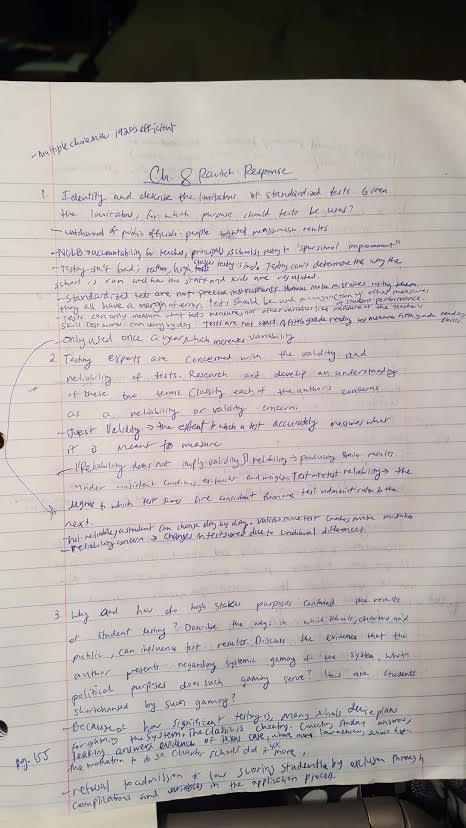
Figure 2: An example of my annotation process on a chapter of the Ravitch text involving standardized testing.
These assignments also acted as a microcosm to research and argument, as they required evidence from the text to prove controlling ideas. For this reason, I enjoyed working through these low stakes assignments while enhancing my reasoning and research skills.
The real bulk of the class began when we were to choose our research topic. Because of our in-class library visit and the Ravitch text, especially the chapter on No Child Left Behind, I gained interest in the erosion of standardized testing. Some are in favor of standardized testing while others think of it as an unfair indicator of success in school children, and because of this political groups, parents, and students are trying to eradicate it. I soon realized that the community’s engagement with the school system was what I was really interested about, more than the factors of standardized testing. I remember speaking with my mother in the beginning of the course about her opinion the American School System because of her position as a high school math teacher. Through our conversation, one thing we discussed stayed with me: her frustration with uninvolved parents. Even at her middle-upper class high school, there are still parents who do not have time to take part in their child’s education. For this reason, I wrote up two prewriting research assignment proposals, the first about the erosion of standardized testing and the second about the problem with uninvolved parents:

Figure 3: My two writing proposals. As shown by the depth of my second proposal, I was more passionate about the my second potential topic.
I thought that the two pre-writing proposals would give birth to a new topic I could research, community involvement in testing reform with an emphasis on parental involvement. Yet, as shown by my Midterm and HCP Reflection, my heart stayed set on discussing the issues behind a lack of parental involvement in the school system.
Though I had found my topic, my conflicts were not resolved. The next step in the process to discussing my topic was discovering to frame it as a pressing problem. I did not originally understand the HCP’s prompt, as I was going to do a whole paper based on research behind the benefits of parental involvement and how it enhances the school system. When doing peer evaluations, I realized that I instead needed to discuss my topic as a problem rather than its benefits in the school system. For example, while going through the “One-Minute Pitch” assignment with classmates, I noticed the word “problem” at the top of the page and immediately panicked, listening to their descriptions of topics framed as problems. This was one of the scariest moments in the class, causing me to question whether I could be taken seriously in the academic community. After this occurrence, I got to work, trying to make up for my time of confusion.
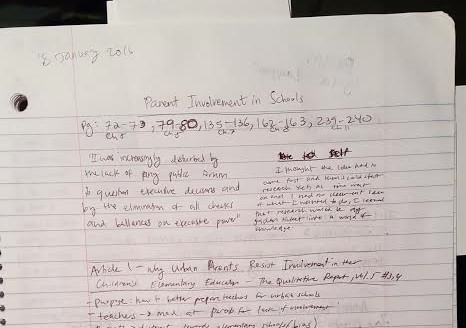
Figure 4: The picture shows a page from my notebook when I was really getting into researching my topic. At the top are pages from the Ravitch text where I found quotes on parental involvement. One of Ravitch’s quotes is shown, as well as a comment to myself. The comment reads: "I thought the idea had to come first and then I could start research. Yet, as time went on and I had no clear-cut idea of what I wanted to do, I learned that research would be my golden ticket into a world of knowledge."
With this, I conducted research and eventually came to my Historical Conversations Project rough draft. Receiving marginalia comments from the professor and peers, as well as visiting office hours, gave me a clear idea of what I needed to improve on. I immediately discovered a lack of context in my writing, as shown in the highlighted portions of this sentence:

Figure 5: The sentence here discusses consequences of students dropping out, which involves weaker schools and a trillion dollars lost, but I was not defining what makes a weak school, and there was no context as to where a trillion dollars were being lost and what that meant for schools or society.
A lack of context in my rough draft stemmed from thinking through a string of ideas and only writing down what I didn’t think was obvious to the audience. However, doing this resulted in skipping steps in argumentation, which caused my sentences to be unclear. My essay aimed to travel from point A to point Z, attempting to stop at each letter in between making sure the audience understood the argument; in my draft, however, the sentences were traveling from point A to point D, from point D to point G, and so on. With this in mind, i started revising by looking over every piece of evidence and really contextualizing events in my analysis. If some of the key events I discussed lacked evidence, I went online and researched more about my topic. The amount of evidence I had directly correlated to the confidence I gained while fitting together puzzle pieces of the problem with my own commentary. I also discovered that holes in my argument could be filled in by further research on key players in the historical conversation of my problem. In the final draft, my sentences were flowing more linearly, going from point A to point B and communicating my ideas clearly.
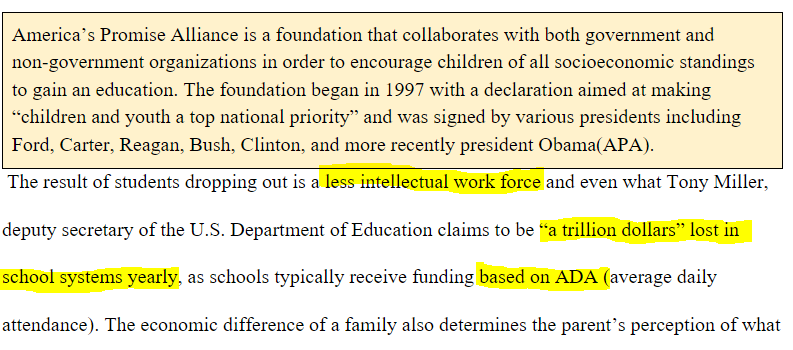
Figure 6: An improved version of figure 5 in my final draft.
In the same sentence that lacked context before, I was able to specify that students dropping out led to a weaker workforce, a current and pressing problem in society. Additionally, I was able to clarify that schools lost money as a result of average daily attendance lowering school funding.
Communicating my ideas did not mean focusing primarily on body paragraphs; revisions also involved adding information to the paper in an aesthetically pleasing manner: through multimodal elements. These elements include pictures, graphs, descriptions, and even subheading for sections of the paper. Initially, I was afraid of multimodality, as it was a new element in my Writing 39 series experience. Yet, as I developed more drafts of my writing and viewed other peer’s work, I became more flexible with the concept. An example of a multimodal element is shown in Figure 6, where I provide information on a significant nonprofit in the HCP paper.
In composing the final draft, I was also able to implement counter arguments, which were partially influenced by classmates. For example, in a small group discussion with one of the German students, I was discussing one of oddities of the American School System, called “snapgrades”. The German student thought that this was an invasive practice for parents, where they can become over involved with their child. From this conversation, I gained an idea on how to communicate my counter argument in the paper. With the addition of multimodal elements, reconstruction of body paragraphs to communicate ideas clearly, and even the addition of counter-arguments, my HCP was complete. I successfully joined the historical conversation of a pressing social issue, lacking parental involvement, and developed my expertise on the subject.
The next step in the course was addressing the pressing problem and advocating for solutions in the Advocacy Project. Even after an in-class visit from one of the school librarians, I was still unsure where to search for advocacy on my topic. For this reason, I registered for a research consultation appointment in Langson Library. The one-on-one experience with a registered librarian provided me with an abundance of resources, and I was able to find more credible sources. Discovering information helped with a preliminary step to writing the AP, filling out “problem maps” assigned in class. After filling out the seven bubble maps, I found it easier to view a summarization of my ideas on paper:
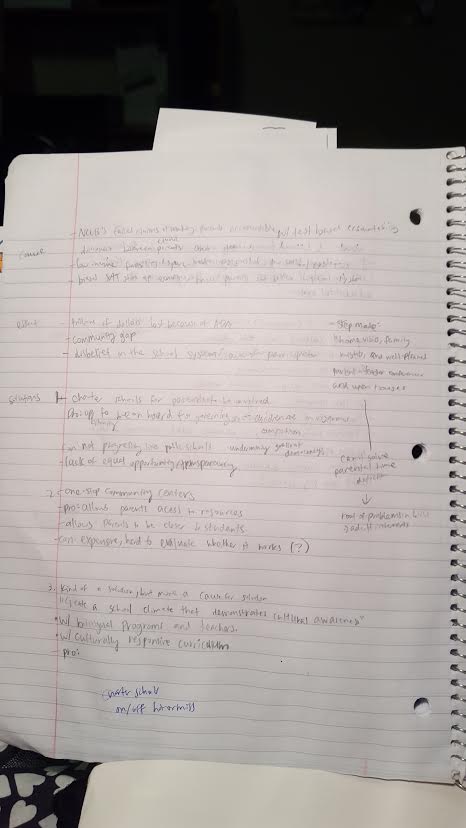
Figure 7: A breakdown of the ideas constructing my advocacy project based on the problem maps.
The biggest struggle in writing the Advocacy project prospectus was figuring out what strategy to use when discussing my topic’s problem. The prompt for the advocacy project gave three options to posing solutions: advocate for solutions, discuss steps to solving the problem, or argue why solutions are not working. Initially, I was writing my project using the third option, addressing why solutions to parental involvement weren’t possible. Through research and composition of the essay, however, I discovered that the evidence I found was more suited to the first or second options for writing the essay. Thus, I made a decision to commit to the second step: posing steps towards a solution and the root causes of the problem.
My solutions made their first appearance in the Advocacy Project Oral Presentation. The presentation helped me present an overview of the problem: who is affected? What are the consequences? What are some possible solutions? These are all questions that helped me shape my presentation, which was a preliminary exhibit of all the research I had done to advocate. After the presentation, I received a five minute time period to receive questions and comments from classmates. While some classmates provided ideas for further research, like mandatory parent programs in specific school districts, others gave counterarguments, which I considered in later drafts of my paper.
The second draft of the Advocacy Essay showed a great exhibition of research, yet even after I implemented everything learned from the presentation experience, the project only addressed the benefits of the solutions posed. There were no counter-arguments addressed, which meant that my paper lacked credibility. For this reason, part of the revision process involved addressing the other side of the argument. One revision strategy that improved the sophistication of the paper was interconnecting my three solutions.

Figure 8: An example of the thesis statement in the second draft of my Advocacy Essay (in the abstract, not concluding the opening paragraph).
Before, they were all presented as separate beads on a string, making readers question how they would be implemented in a realistic scenario. As I weaved the solutions together, my advocacy and position was becoming clear, and I was realistically contributing to a conversation of scholars as an emerging expert.

Figure 9: An example of the edited thesis statement successfully concluding the opening paragraph in my final draft AP.
One of the defining moments in this class was realizing that my solutions can be interconnected. I was in office hours, attempting to discuss the argumentative aspect of my paper, which was underdeveloped according to comments by the Professor and students on my draft. I didn’t understand what it was lacking or how I could improve my writing. After a thorough discussion with Professor Kongshaug, I realized that these steps to solving the problem are most effective when acting in harmony. Walking back to my dorm, my mind was racing and I was developing ideas for my final submission. In the process, I furiously scribbled my thoughts, not wanting to lose them:
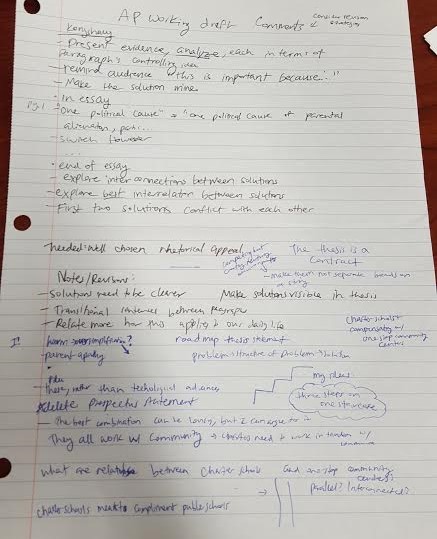
Figure 10: A key part of the composing process: having a revelation about how to address my solutions. Some of the comments include: “three steps on a staircase” and “what are the relations between charter schools and one stop community centers? Parallel? Interconnected?” With these comments, I was trying to address the confusions on how my solutions connect. During the course, taking notes after communicating with peers and the Professor gave me notes to base writing and research off of later.
My participation in this Writing 39C course, including reading the class text, collaborating with other academic citizens, researching, and writing, has been significant in terms of my academic evolution in lower division writing. Previously in Writing 39B, I learned how to use rhetoric in writing, communicating to an audience through alternative sources. In this course, I have obviously gained a higher understanding of the class theme, the American School System. During the time, I also became an expert on my topic, a lack of parental involvement. Yet, in a broader sense, I learned how to successfully conduct research, analyzing sources and delivering my own significant arguments. I was always able to casually form an “argument” in a conversation with friends or conduct “research” by looking the weather up on google. Yet, this class gave me the opportunity to conduct research in order to contribute to the academic community. From my research, I could argue my position with knowledge, sticking my neck out and engaging with a community where I originally stood no chance. In other words, I have been given the tools to be taken seriously in my academic writing, whether that meant broadening my horizons through other’s expert opinions or elucidating my unique claims. The tools I have learned in this course will not only help me in my future writing endeavors, but also in communicating with other scholars as I engage in my studies. I have learned the art of academic research and argument; most of all, in an academic setting, I have learned how to be taken seriously.
 icons at the top right corner of the subsection.
icons at the top right corner of the subsection.